Great Danes come in a range of beautiful colors. Brindle, merle, black, mantle, fawn, blue, and harlequin are the 7 colors typically accepted in the written breed standards. Deviations from the breed standard can result in a range of coat colors not traditionally associated with Great Danes. There exists a prevailing concern among breed enthusiasts and experts regarding the intentional breeding of off-standard and designer color Great Danes.
Merlequin, Brindlequin, Fawnequin, Lilac Merle, Tan Point, and chocolate are popular ‘off-standard’ colors, to give you some examples.
Many Great Dane owners are drawn to breeders who focus on creating eye-catching coat patterns in their puppies. Read on to learn more about this controversial practice!
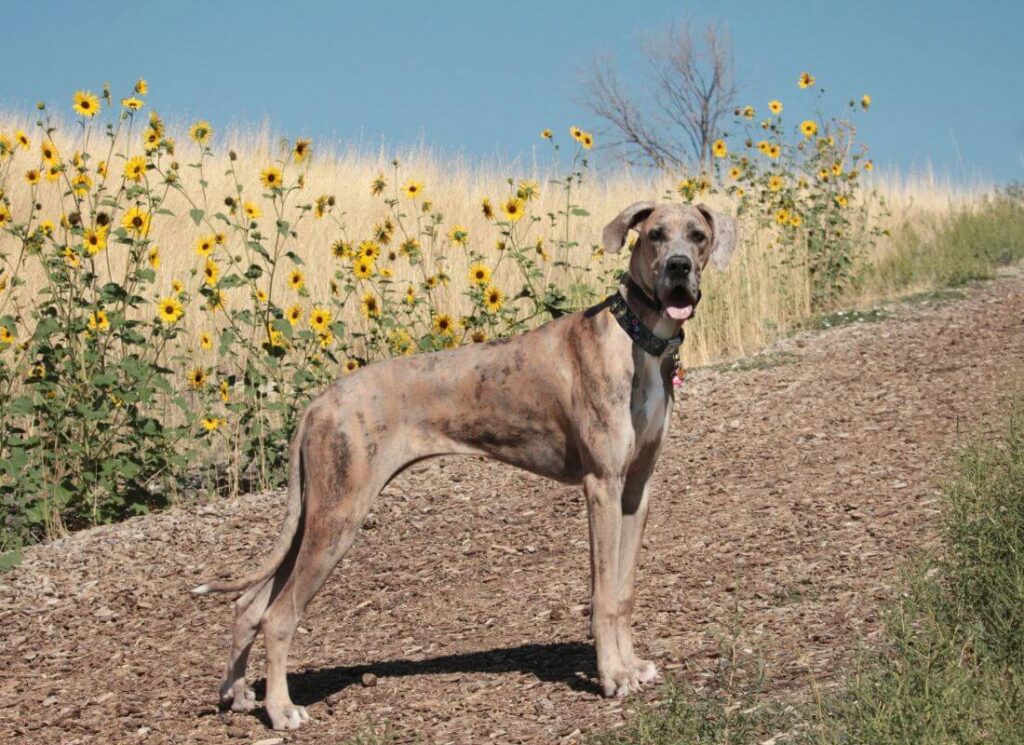
What is an Off-Standard Color Great Dane?
This is a big one folks, buckle up!
What is an off-standard color Great Dane, or “designer color’ Great Dane?
It’s a Great Dane that is NOT one of the 7 currently accepted colors in the written breed standard.
The 7 Great Dane colors are Black, Mantle, Blue, Harlequin, Merle, Brindle, and Fawn. You can read more about them here: https://www.hellodanes.com/great-dane-colors/
Mis-marked versions of the accepted colors (for example, a Fawn with no black mask or a Brindle with a white chest are always a penalty in the show ring, and any color that isn’t one of those seven is automatically disqualified from the show altogether. Most can be registered, however!
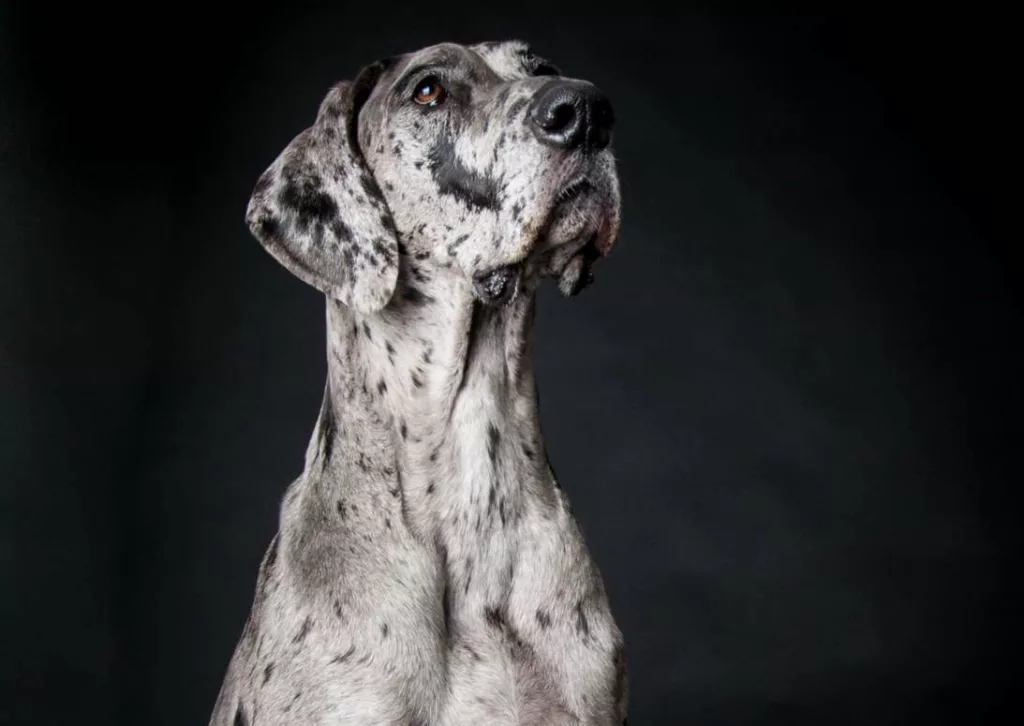
Color Purists vs. Color Enthusiasts
There are two major schools of thought on this one.
Color Purists & Breed Preservationists
This group believes that purposefully breeding Danes in off-standard colors is bad and that new colors should only be added to the accepted color code following diligent research into the color and its benefit to the preservation and health of the breed.
They believe that breed color families should rarely be mixed.
Color Enthusiasts
Believe that if a color is naturally occurring in the breed, it should be allowed to be bred and allowed in the show ring and that it’s in some ways discriminatory to exclude quality Danes that come in colors outside of the 7 outlined in the written standard.
They believe there is no problem with mixing color families.
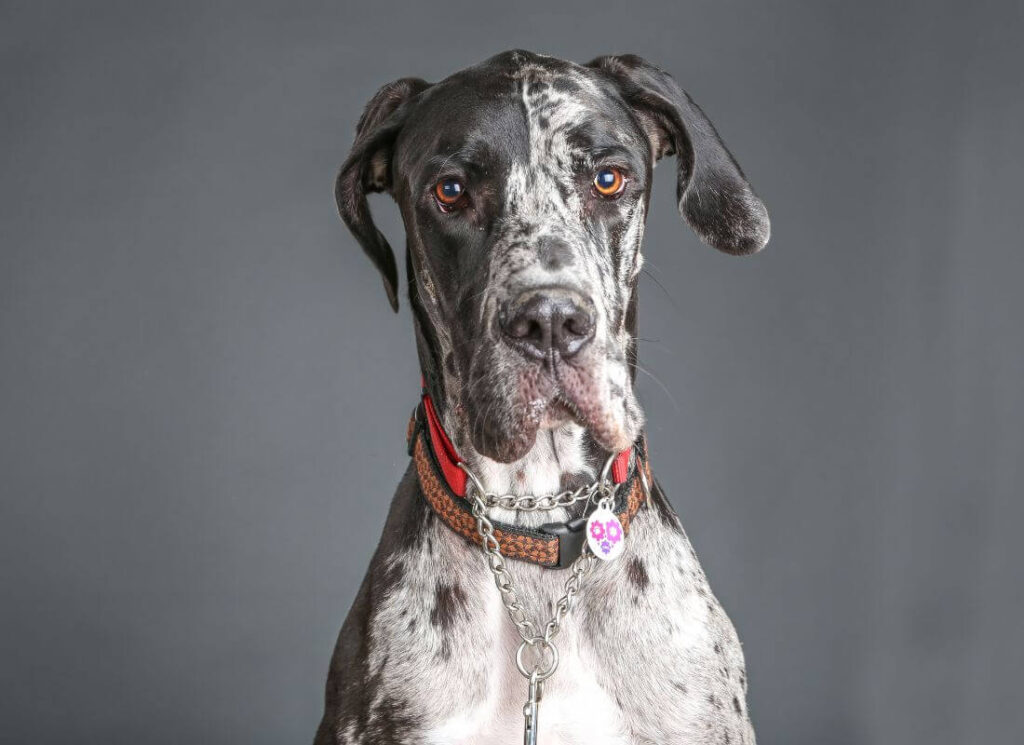
How do Great Dane Color Families Work?
Without getting into the nitty gritty of genetics, it’s important to understand that as a general rule there are only a few ‘color’ families:
Breeders typically breed within these families:
- Harlequin / Merle / Black / Mantle
- Fawn / Brindle / Black
- Blue
The color purist breeders will mix and match within those families. They may pair a fawn and a brindle together or a harlequin with a mantle, for example. Their goal is to create colors that meet the breed standard.
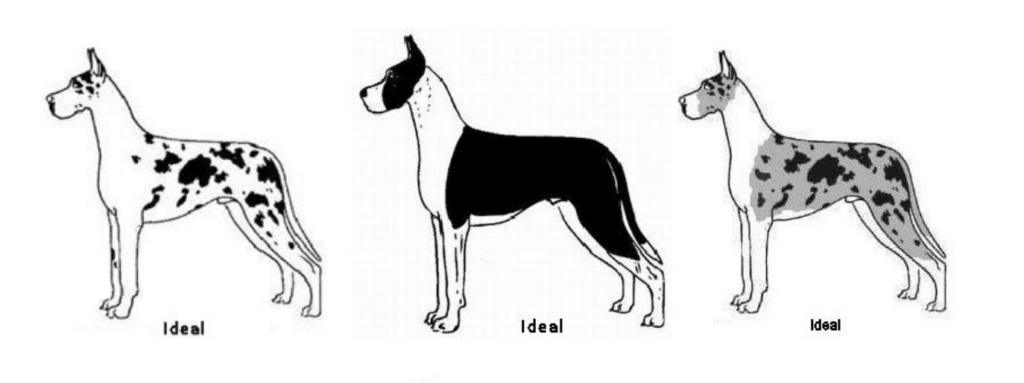
The color enthusiast breeders will mix them up, choosing to pair a harlequin and a brindle or a blue and a merle, for example.
If you are a geek about this stuff, we encourage you to visit the fun coat colors group on Facebook!
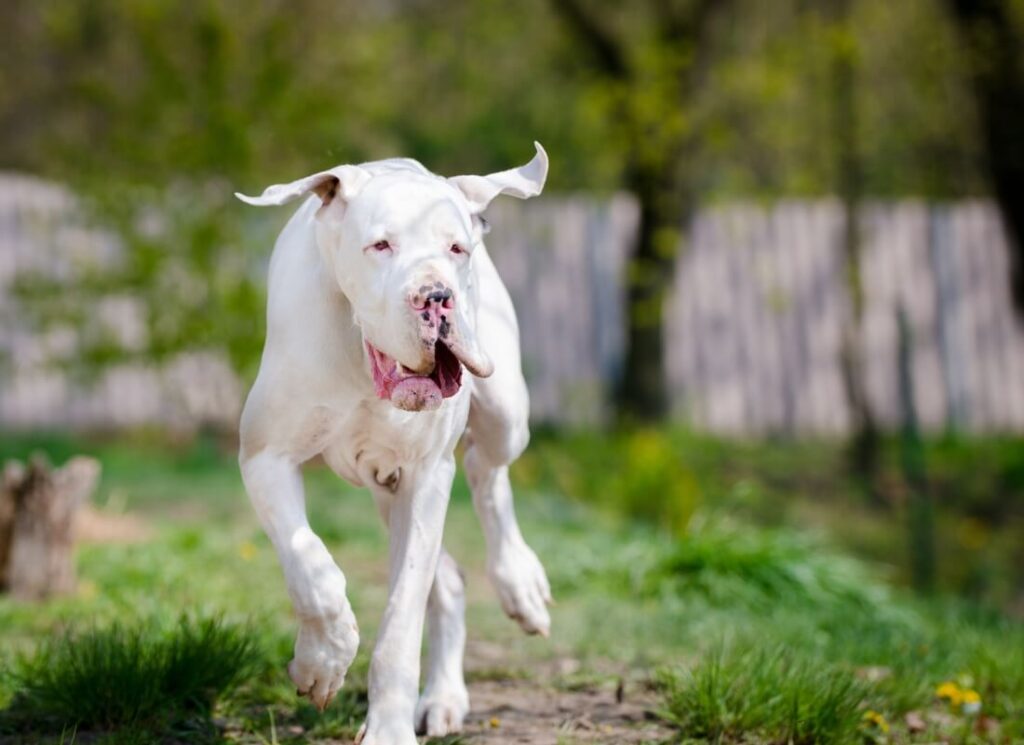
Is Breeding Off-Standard Colors Ethical?
Now of course, we can look at this and think ‘well, what’s wrong anyways with pairing a harlequin and a brindle together? Brindlequin dogs are so neat looking!’
The issue is actually more complicated than many think.
Many color enthusiast breeders will intentionally pair already off-color-standard dogs with other off-color-standard dogs.
For example, fawnequin + lilac merle or chocolate + mantle-marked brindle to see what neat colors come from the pairings.
The result? Tons and tons of ‘new’ and interesting markings on litters of Dane puppies. Great Danes are very special this way.
In many cases, the off-standard litters being born are a FUN surprise for the breeder and those interested in the puppies! It’s incredible for social media AND for sales. That right there is a major red flag.
This practice of creating off-standard colors is naturally rewarding because of this. The problem? These breeders are being rewarded for focusing on color first, not temperament, structure, and health.
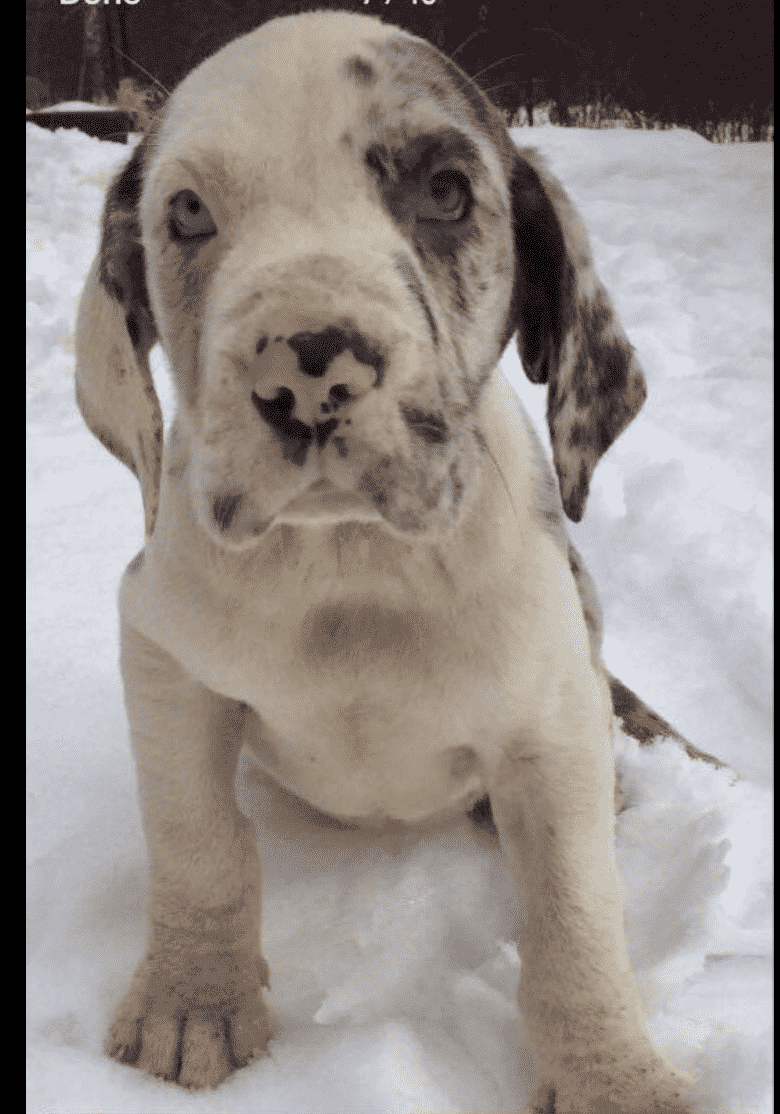
Off-Standard Colors are Fun
Here is the problem, though.
Off-standard colors are excluded from being shown.
Say what you want about show dogs, but dog shows are one of the only ways a breeder can verify that the dogs they are breeding are structurally sound.
What we are seeing as a result?
100’s of Great Dane breeders so focused on creating fun designer colors that they cannot see the forest for the trees.
Great Dane health & structure are suffering.
Yeah, we’re going to go there.
When a breeder is choosing dogs to breed, they should be first focused on structure and health.
Ethically, they must choose full health testing of both parents (hips, heart, eyes AND thyroid) and seek feedback from peers (in dog shows and otherwise) to make sure that they are breeding dogs that have excellent genetics.
Unfortunately, many (of course, there are exceptions) ‘color breeders’ are so focused on color that they disregard the original form, shape and function of the Great Dane….often to the detriment of their health.
What ends up happening is the creation of 1000’s of Great Danes in ‘unique’ colors, made to sell easily to unsuspecting buyers, that come from breeders who don’t have the best interest of the puppies in mind.
Basically put, that’s a lot of Great Danes that are contributing to an increasingly alarming problem of poor overall health, temperaments and structure.
Extremely droopy eyes, flat feet, roached backs, bloat, wobblers, cancer, cardiac problems, cataracts, entropion, seizures and thyroid problems plague Great Danes. While one individual puppy may be ok, over time these incremental changes are problematic.
Because off-standard colors cannot be shown, there are no checks and balances for breeders that focus their breeding program on color.
Basically put? It’s a free-for-all.
Some breeds have addressed a similar problem by creating a scoring sheet that can be used to evaluate if a single dog is breeding quality, without the breeder needing to get into the show circuit.
That’s not happening in Danes that I am aware.

Some Off-Standard Dane Colors are Especially Bad
All or mostly white Great Danes and Merlequin Great Danes (looks like harlequin but with merle patches, no black ones) are most often the result of unethical spot-spot pairings.
Also known as Double Merle Great Danes, white Danes may be deaf or blind and many have internal health problems (autoimmune disorders, seizures, allergies, etc.) and poor temperaments.
These dogs are 100% preventable through thoughtful breeding practices & genetic color testing.
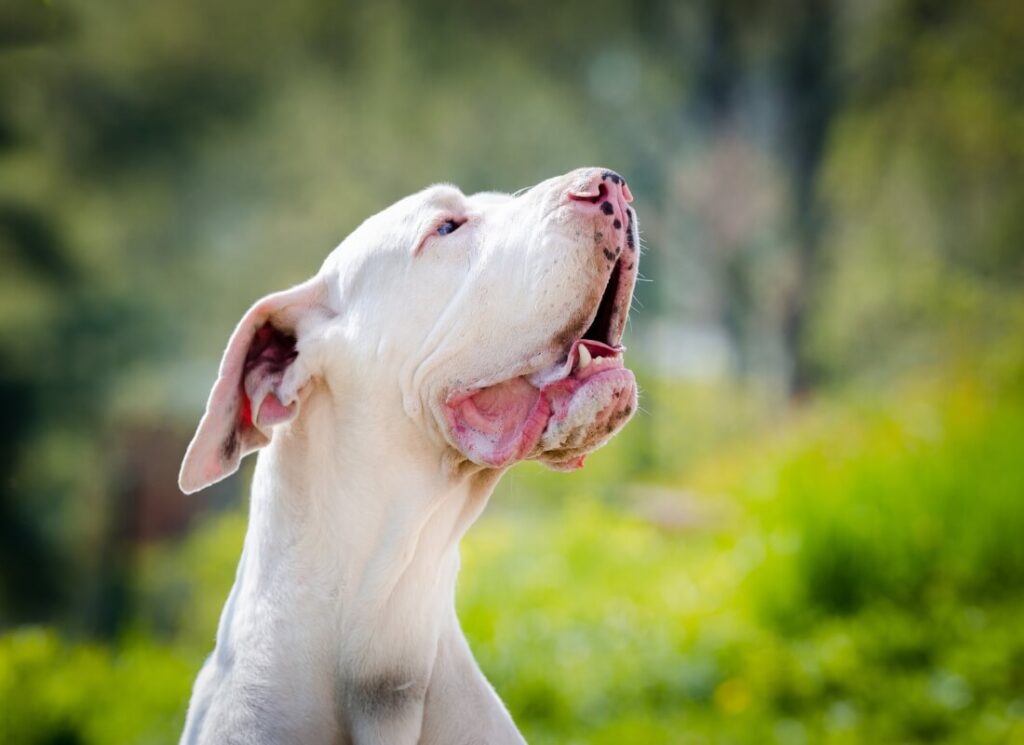
Double Merle Breeding in Great Danes
What’s so interesting about double merle Great Dane dogs is that it’s a problem for both color pure and color enthusiast breeders!
Color Purist breeders
These breeders may pair Harlequin + Harlequin to create ‘show marked’ Harlequin dogs.
They often cite that there aren’t enough quality black or mantle studs to use, so this is the only way. They know that double-merle puppies are a consequence of that, and some will even euthanize those puppies before 5 weeks of age. The GDCA condones this practice.
At least these puppies DO tend more often to come from well-structured, well-tempered proven dogs, and some breeders who do this see to it that the DM dogs from these litters live long, healthy lives in carefully selected homes.
Advances in genetic screening and our understanding of the Merle gene have made this practice safer, too.
Color Enthusiast breeders
These breeders often end up with double-merle puppies because they weren’t aware it could happen (for example, if they pair a fawnequin with a lilac merle, which sounds cool but is a really, really bad idea), or because they didn’t color test and know that a solid-color dog in their program was a cryptic merle (a black Dane, for example, that recessively carries the merle gene), or they did it intentionally because they know they could get the super popular color puppies (which may also be deaf or blind).
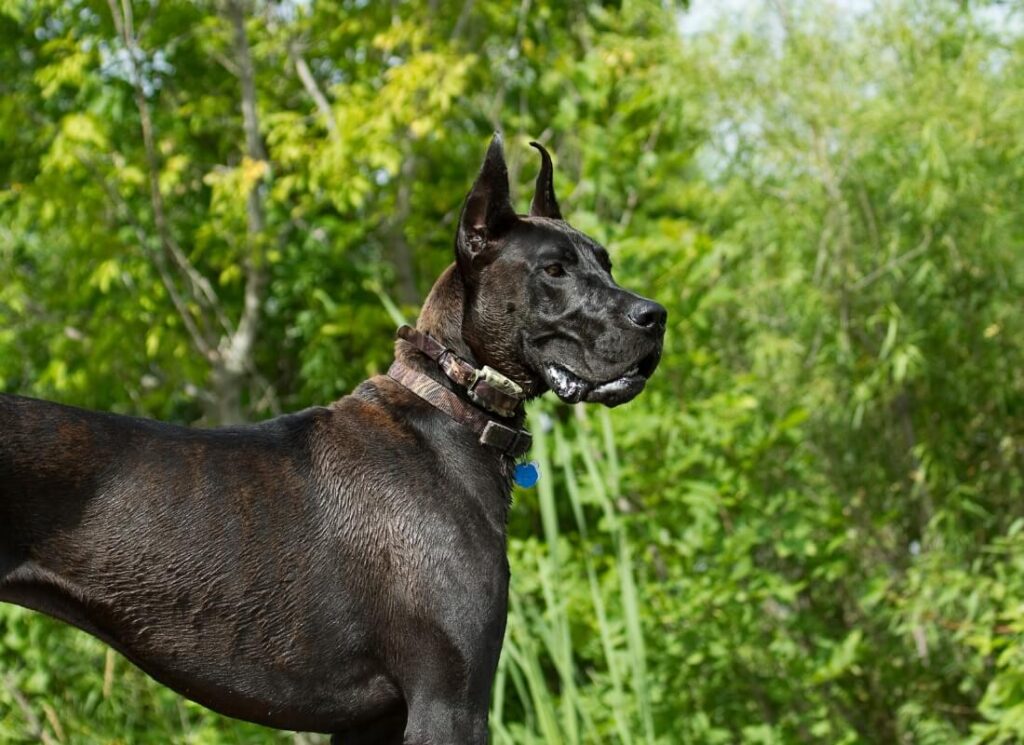
Great Dane Coat Color and Health
Double Merle puppies will nearly always have some kind of health issue, mild to extremely serious.
There is some information bouncing around that modifying the black spots to fawn on a Great Dane (Fawnequin) for example may impact internal health, though we’d like to find more information on this.
If that is truly the case, there are many off-standard colors that would be extremely unethical to pursue off-standard colors for this reason alone. More research is needed.
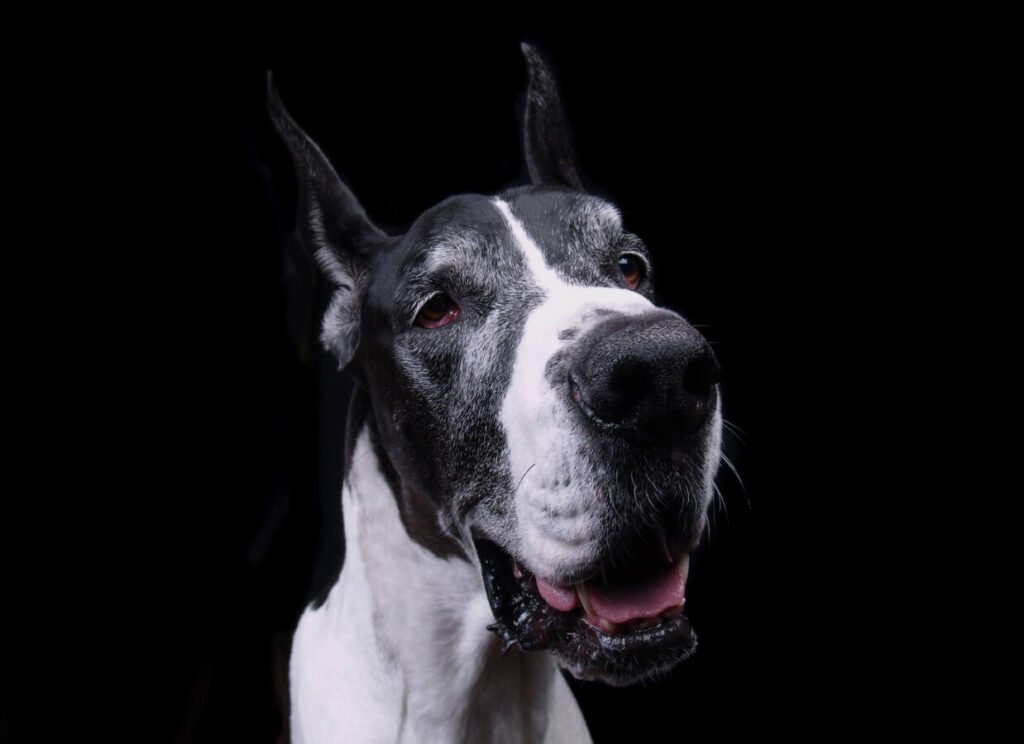
Off-Standard Colors in Well-Bred Litters
Ethical breeders who work within the outlined standard color families can and do occasionally get a surprise off-standard color puppy.
Some are mis-marked, heavily marked, or the result of recessive genes.
Unlike dogs from color-focused backyard breeders, however, the random off-standard pup in a litter will never be sold for breeding, will have come from well-structured dogs, will not be sold at a higher price as ‘rare’, and will be supported for life.
We will continue to repeat this:
Ethical breeders focus first on structure, genetic health and temperament. If the focus is first on creating unique colors, there is a problem.
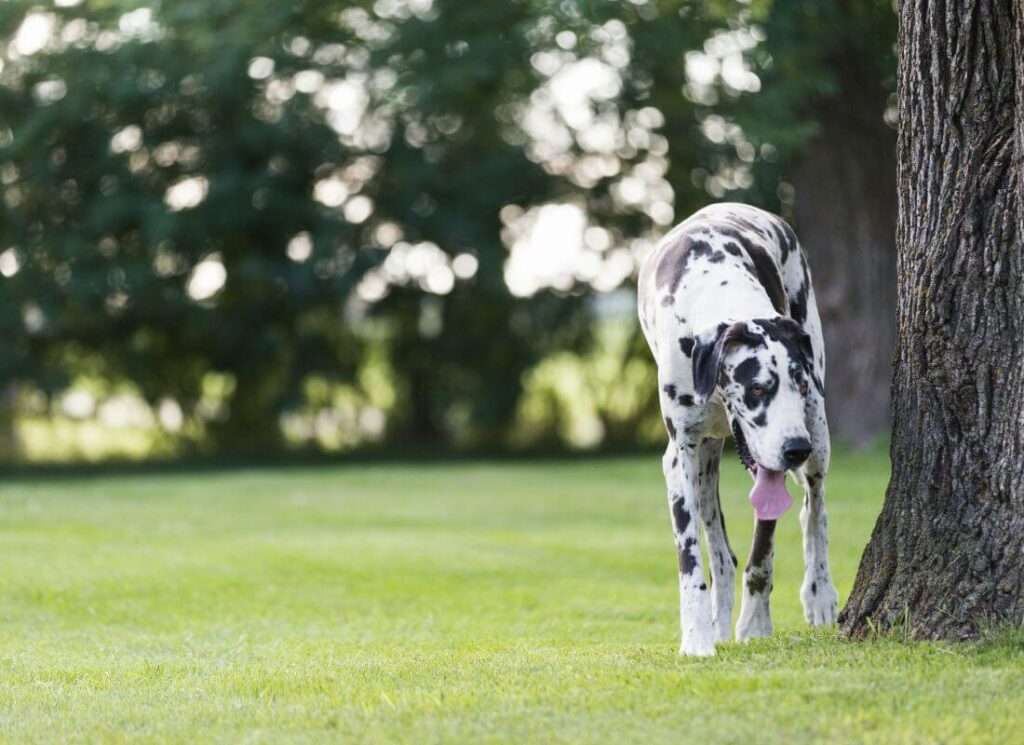
Off-Standard Colors and ‘Racism’
Some backyard breeders, when faced with those that don’t support intentional off-color breeding, will say that those people are being ‘racist’.
We cannot think of a more tone-deaf statement, to be honest. Comparing human skin and human experiences involving racism and discrimination to dogs’ coat colors is extremely misguided and ignorant.
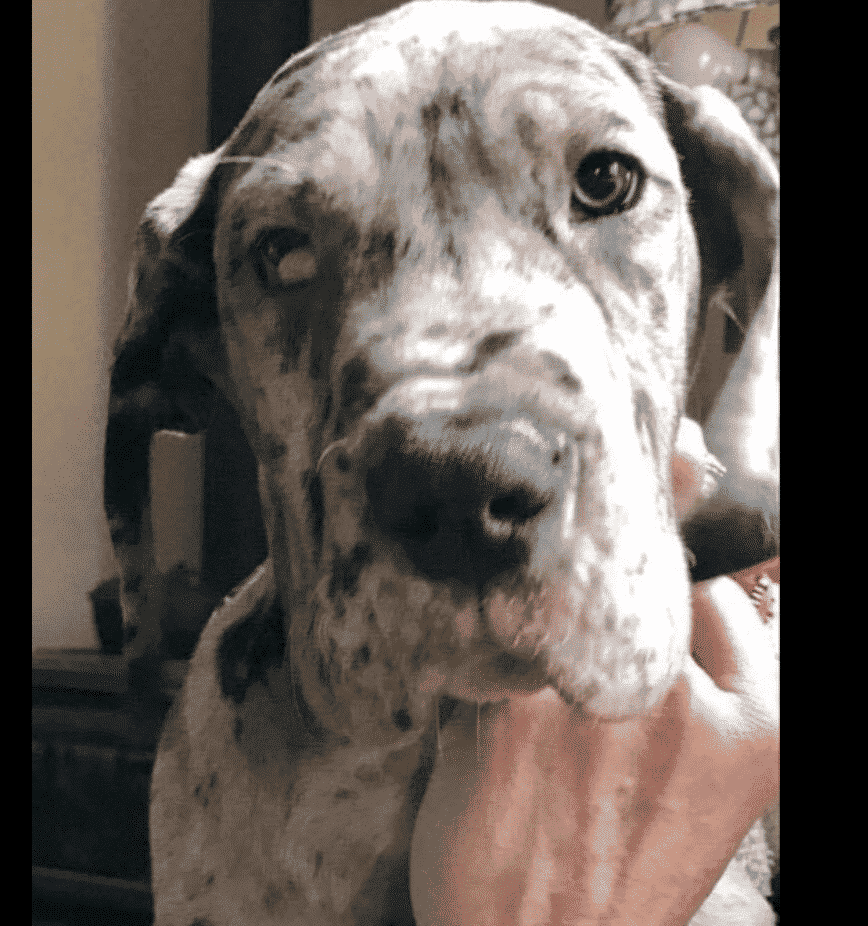
The Honest Truth About Intentional Designer Color Breeding
Take a look at this sickly designer color puppy above while you hear us out.
There are two kinds of Great Dane breeders.
BREEDER #1
- Cares very much about the puppies they produce. Profit is not the goal, health is.
- Temperament, longevity, and structure matter to the point where they are willing to NOT breed a dog that doesn’t meet their standards.
- They support buyers for life.
- They spend a lot of money on health testing, genetic screening, training and socialization.
- They invest hours of blood sweat and tears into their dogs and care very much about every puppy they produce.
Breeder #1 is breeding dogs to better the breed and to ensure that those who share their lives with that puppy are presented with an animal that has every opportunity to be a happy, healthy, friendly and robust family pet, in ANY color.
BREEDER #2
- Cares mostly about profits and fun.
- They may be friendly and even caring towards owners and the puppies they produce, but they are willing to cut corners.
- They may only partially health test the parents (choosing to do only hip scans, for example, so they can tell you that they are ‘reputable and health test’)
- They are often blind to the structural problems they are passing on.
- Droopy eyes, roached backs and a mild problem with aggression towards dogs or people may be common.
- They don’t always support buyers for life
Breeder # 2 has learned that there is no reason to fully health test the parents or ask for honest feedback on their structural health when they can paint the puppies ‘Lilac Merle Euro‘ and sell them at a premium, basically.
Now be honest…knowing that this is how it often works for ALL Great Dane breeders (standard colors or not), which breeder would you rather support?
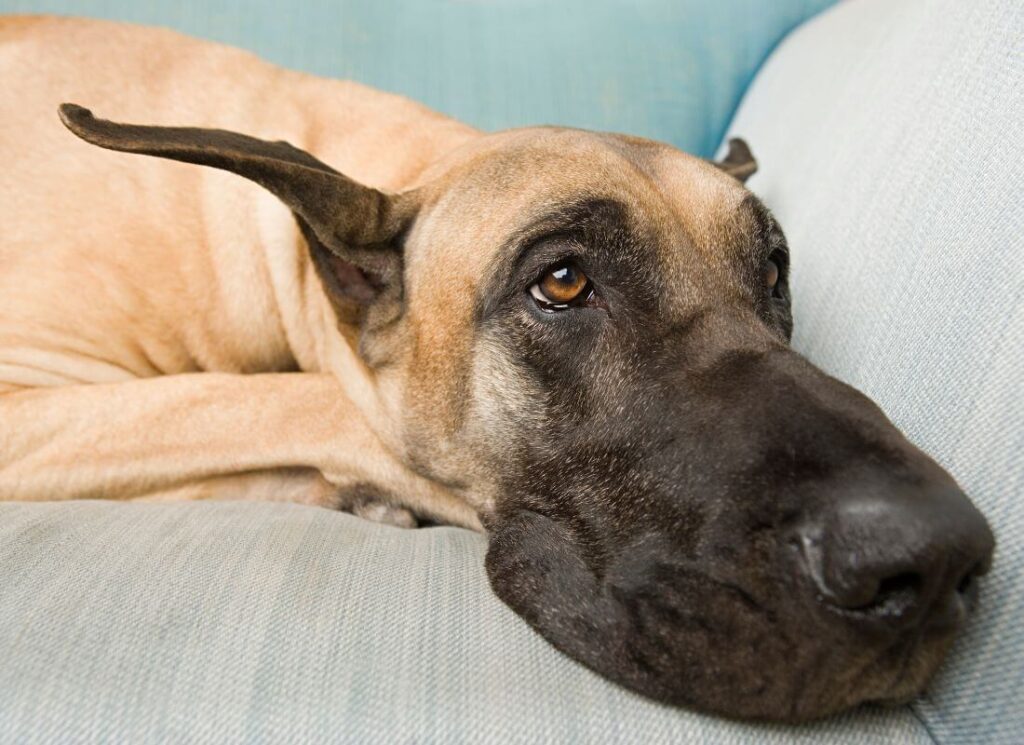
Off-Standard Colors can Muck Things Up
We are already having a huge and growing problem in Great Danes when it comes to longevity, health and temperament.
So when breeders intentionally pump dogs into the system that don’t meet the breed standard for structure and come in a range of neat colors, things get messy.
This is especially true if breeders are selling off-standard color dogs to other breeders.
This practice is introducing a massive range of new color genetics (dominant and recessive) as well as perpetuating common structural & health problems.
Over time, this could mean that it becomes more and more difficult for breeders to find and use quality dogs for breeding.
Many say that additional colors are necessary to diversify the gene pool, and we don’t necessarily disagree. It honestly seems pretty silly to exclude a healthy, well built dog from a breeding program or dog show just because it’s not a ‘standard’ color!
However, those additional colors need to be ethically produced. As it stands right now? Most really aren’t.
Dare we say this?
Off-standard color breeding is largely a practice of backyard breeders. This is a sad and unfortunate truth that needs to be addressed if more off-standard colors are to become a reality in the Great Dane color code.
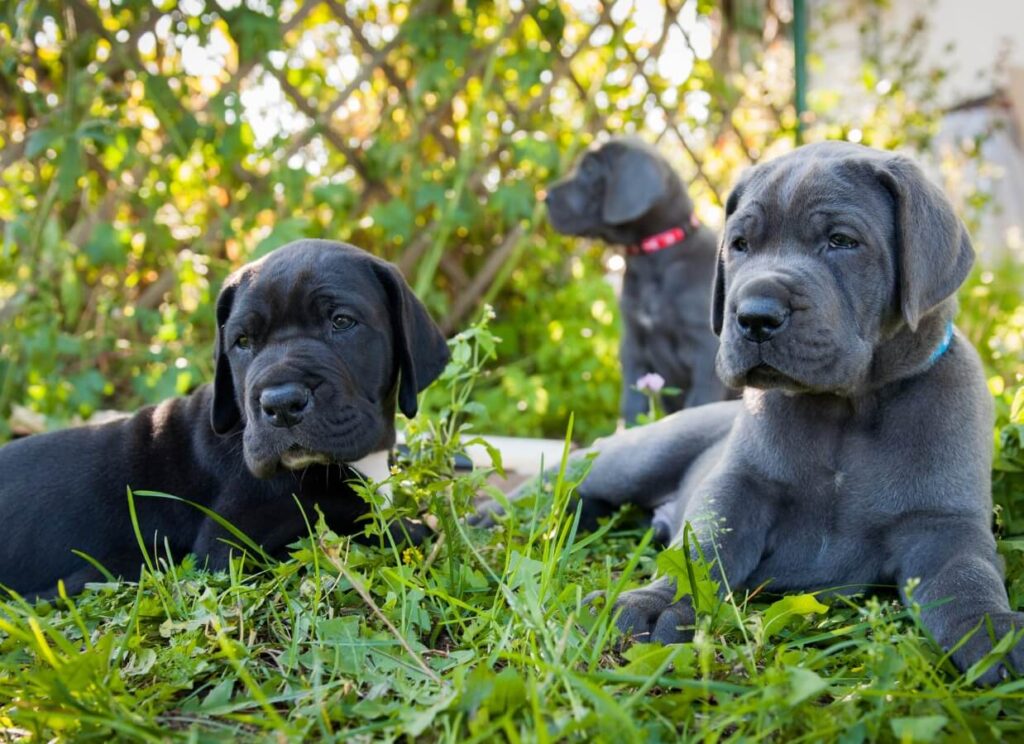
Adding New Colors to the Great Dane Breed Standard
Merle was added to the GDCA color code in 2019 when it was recognized that this color was a common and natural by-product of ethical pairings, served to help diversify the gene pool, was being bred with outstanding health and structure and wasn’t resulting in notable health problems.
Mantle was added in 1999, for the same reasons.
Chances are, additional colors can be added to the color code and eventually shown as well, especially if those colors are a natural byproduct of thoughtful dam/sire pairings.
Unfortunately, backyard breeders are not going to be able to make that happen. As long as their focus is on color and not health, the breed club has no legitimate interest in listening.
The currently accepted colors are there for a reason, while the off-standard colors are not…for a reason. Those reasons need to be addressed.
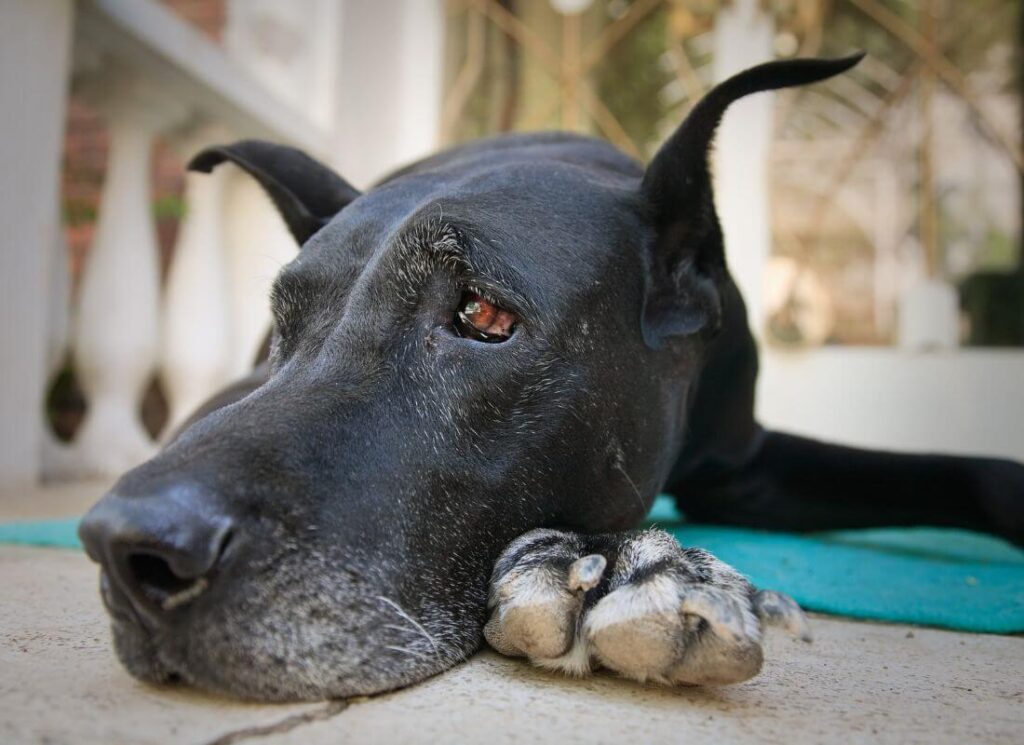
How Do We Fix This?
How do we encourage ALL color-focused breeders to choose ethics, and to focus on the breed as a whole before focusing on color-driven profits? Here is what we would love to see:
- No more cutting corners. FULL health testing of both Dam & Sire, no matter what. Heart, Hips, Eyes & Thyroid, no excuses.
- Genetic screening and pedigree study for color genes and common genetic issues (bloat, Von Willebrand’s and IMGD, for example).
- Submit dogs for structural evaluation. While off-standard pups cannot be shown, there is no reason to hide them from the world. The Great Dane Conformation Clinic on Facebook is a great resource.
- Be willing to wash dogs from the breeding program that don’t pass health testing or meet basic standards. There is no excuse in the world for breeding a dog that has flat feet, a roached back, narrow hips and a genetic history of aggression, bloat or wobblers!
- Stop selling ‘designer’ color puppies to other backyard breeders. Be choosy!
- Stop marketing off-standard color puppies as ‘unique’, ‘designer’ or ‘rare’. It’s misleading to buyers who want a healthy, robust family pet and believe they are receiving a ‘premium’ dog.
- Only breed parents that have excellent temperaments.
- Title the dogs! Train them and get CGC or trick or dock diving titles. Prove them in some way. Stop hiding them from the world. A lilac merle or brindlequin Dane with exemplary structure and temperament kicking butt in obedience and sports would go a LONG way towards encouraging positivity towards off-standard color breeding!
- Stop hoarding dogs; if there are too many for each to have a rich family life, enrichment and loving retirement, it’s not ethical.
- Support puppies and buyers for life. Keep those babies out of uneducated or abusive homes and out of rescue, please.
- Don’t breed spot-to-spot, especially if the result is that the sick pups will be euthanized or dumped into rescue or into abusive and dog hoarding situations.
We’d like to think that none of this is all that difficult, but we understand that for many profits and fun will always trump ethics.
Our hope is that buyers see this, know the difference and choose which breeders to support accordingly.
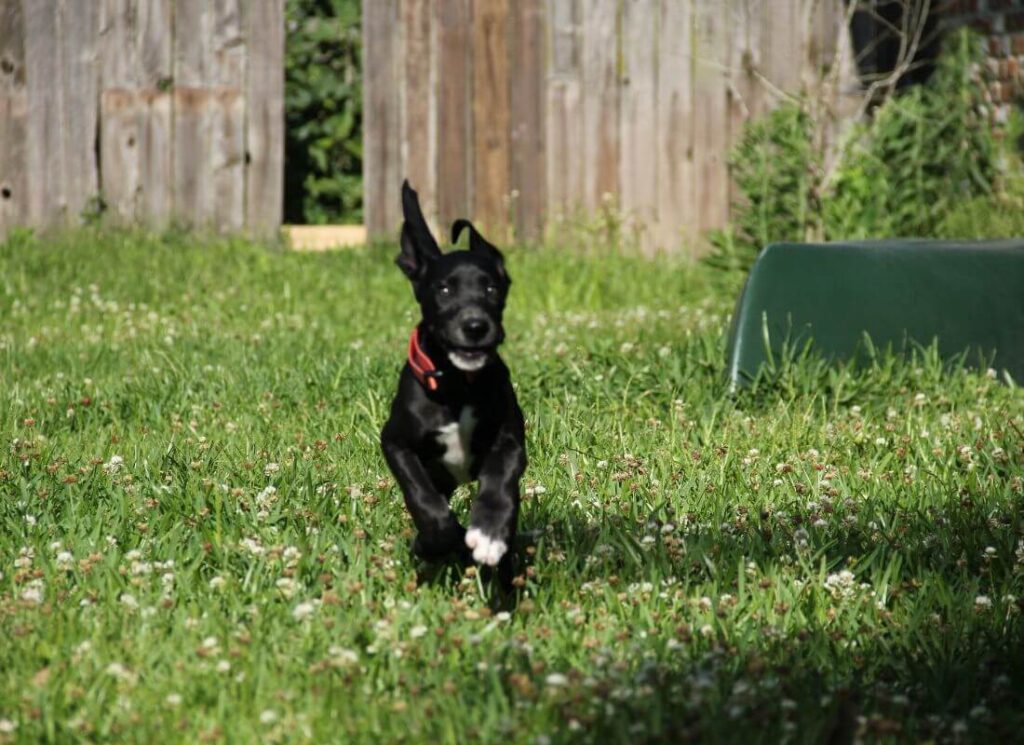
See it yet?
It’s not the color of the puppy itself that’s the problem.
It’s the unethical corner-cutting profit-driven breeding practices that led to it.
We understand that off-standard color puppies are fun and unique.
It’s so simple. Meet the basic standards of ethics. Prove us wrong!
Show us that breeding for off-standard colors can be done right ethically
Want a Great Dane in a Designer Color?
Don’t feel guilty about that. Danes come in some really unique colors!
This fawnequin (from a breeder on our ‘bad breeders list’) is a classic example of backyard breeding, and exactly what you want to avoid, however. The pursuit of this color meant that aspects of health and structure were grossly disregarded.
Look for and verify that the breeder you are interested in is FULLY health testing both parents (hips, heart, eyes, thyroid), is supporting buyers for LIFE no matter what, is fully socializing the puppies and keeping them until at least 8 weeks of age, and that the pedigree is free of heart problems, wobblers, bloat, dysplasia and aggression.
If they cannot answer those questions or share that information, look elsewhere. We can paint puppies any color we want to, but it the color won’t matter if they are sick.
If you have an off-standard pup, get out there and love the CRUD out of it! All Great Danes deserve the best home ever. We love all Great Danes, no matter what color they come in!
We will never fault a Dane owner for the dog they have and love; after all, these beautiful creatures become loved family members no matter what they look like!
Our hard stop is on the bad breeding practices though. That needs to be brought to light…so where we are. Please share this post. Dig deep! Re-evaluate what you think you know about off-standard colors and hold breeders to a higher standard!

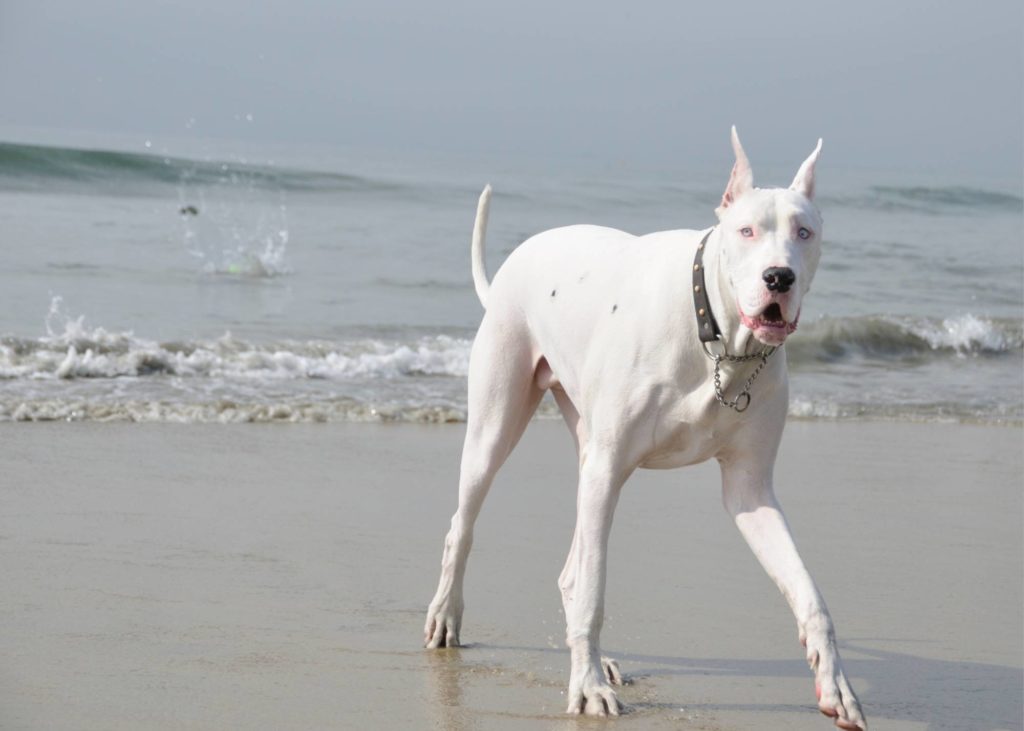



2 Responses
This article is great! I have an off standard color blue harlequin that will be the first for my breeding programs, but she comes from a very good pedigree and proven lines with health tested parents. She will be health tested and we are working on getting her in sports, and the male I plan to breed her with is chocolate, but also good pedigree, health tested, and is in dock diving and doing very well. I wish I could show her because she has good confirmation from what I can tell, but I will submit her to a confirmation group because I want to know how her structure holds up in other peoples eyes. If there aren’t good and ethical breeders out there breeding these colors, the BYBs are only going to dominate.
Thank you SO much for sharing and for wanting to be a diligent, thoughtful breeder. The conformation groups are always friendly and helpful from what I’ve seen, and will be able to help you evaluate strengths and faults. Plus, we find it really interesting to see what they say! You are 100% correct too, if we don’t have ethical breeders out there, the backyard breeders will dominate. It’s going to continue to ruin this beautiful breed we love so much, and we love hearing from people who want to put a stop to that. Keep us posted on your journey! 🙂